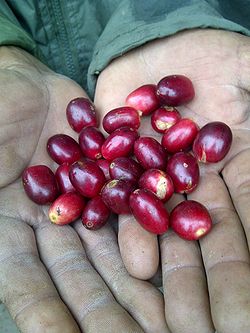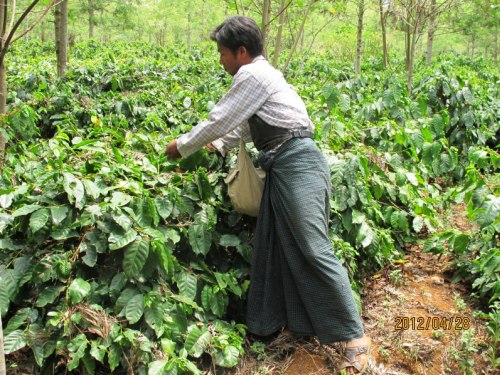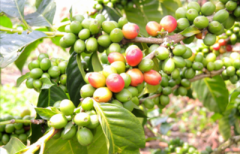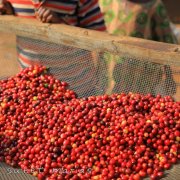Introduction to the flavor and taste of Framoka coffee beans dried on trees in Hara, Ethiopia
For professional baristas, please follow the coffee workshop (Wechat official account cafe_style)

Ethiopia-Haramoka
Ethiopia is the country where coffee was first discovered. Today, there are still many wild coffee harvested by farmers in the primeval forest. Ethiopia is a country with poverty, drought and civil war. However, it is still the most important coffee producer in terms of coffee quality and output, and it is also the best and top coffee producer in the past one or two years. Ethiopian coffee can be divided into two major treatments. Washing treatment method II. Natural sun treatment. Nowadays, every producing area, cooperative and even a small coffee farm in Ethiopia produces coffee beans of the above two treatments at the same time, whether it is the well-known Yegashifi or Sidamo producing areas in Taiwan, which not only makes the coffee different in treatment, but also makes the aroma and taste different due to the adjustment of different techniques and processes. The difference in aroma between Yega Chuefei sun-dried beans and Sidamo sun-dried beans is often misleading.
In recent years, many emerging small producing areas or cooperatives in Sidamo and Yegashafi production areas will be sold in the international market under the names of their own cooperatives or farms, which shows confidence in their own coffee. Hope to establish brand and loyalty in the international coffee market, coffee farmers insist on picking mature coffee beans and strictly handle every process, whether it is natural washing method or natural sun drying method. Unexpected aroma and excellent taste, which I think is the reason why Ethiopian coffee is expected by coffee fans every year. For example, the Dutch government-assisted Red Cherry Project (Operation Cherry Red) impressed the world with the magnificent aroma of strawberry cookies in 2008 and Cambedo Manor in 2009, which has been reinforced by sun-dried beans produced in Ethiopia in recent years.

In his early years, Hara was the largest producer of sun-dried beans in Ethiopia. All the coffee farms produced sun-dried beans and were praised, but the emerging sun farms all over the country almost covered Hara, an ancient city independent to the east. However, Hara still followed the road of traditional production, just like Yishi Mary coffee grew and matured from the tree and was exposed to the sun directly on the tree. It looked like a raisin. Then the coffee farmers fell to the ground to pick up and tear off the peel and pulp to take out the coffee, the production process did not use any machines, and the screening relied only on experienced hands and eyes. Bad beans, black beans, unfermented beans, stones, were not picked out and mixed in coffee beans, so the quality of Haramoka lies in human factors, and it seems that it has not been able to improve into an experienced good coffee in recent years. However, the magic of Haramoka also lies in the barbarism and carelessness brought about by these shortcomings, although the sun-dried beans in different Ethiopian producing areas have different amorous feelings. However, I still miss the most primitive Haramoka without too much decoration.
The end of shallow baking (City): Haramoka grinds with a huge aroma of dried plums and Hawthorns, emitting flowers and fruits of citrus and mandarin when boiled, with a thick and earthy flavor, which is the characteristic and biggest disadvantage of Haramoka, citrus acid complexity is high in many levels, but the whole is not well balanced, the sweetness of bergamot, and the finish is full of fruit fermentation sweetness.
The second explosion of re-baking (Full City): 25 seconds after the first explosion is the heaviest baking degree of Haramoka, so as not to scorch the tips of the low-density Haramoka, the coffee has the aroma of hazelnut cocoa balls after grinding, a hint of pepper after brewing, the sweetness of tropical fruit pineapple guava, smooth tea but not thick without bitterness After cooling, the almond with noodle tea has a thick orange acid left on the throat.
Important Notice :
前街咖啡 FrontStreet Coffee has moved to new addredd:
FrontStreet Coffee Address: 315,Donghua East Road,GuangZhou
Tel:020 38364473
- Prev

It is recommended to analyze the roasting degree of Rwandan coffee. Rwandan coffee is suitable for hand siphon press.
Professional barista exchanges please follow the coffee workshop (Wechat official account cafe_style) Rwanda Qikwei Rwanda Kigowe] * every year March is the coffee season in Rwanda, now is the time for African beans to feel a strong impression of wild and unrestrained, but Rwandan coffee is so soft, fragrant, granular and much milder than beans elsewhere.
- Next

How to drink Rwandan Blue bourbon Coffee? description of the flavor and taste of Rwandan coffee beans
Exchange of professional baristas Please follow the coffee workshop (Wechat cafe_style) Rwanda coffee produced in Rwanda always gives the impression of being wild and unrestrained, but the coffee from Rwanda is so soft, fragrant and saturated with particles, this is my first impression of Rwandan coffee, as far as Africa is concerned. The coffee industry in Rwanda is really eye-catching because it should be
Related
- Detailed explanation of Jadeite planting Land in Panamanian Jadeite Manor introduction to the grading system of Jadeite competitive bidding, Red bid, Green bid and Rose Summer
- Story of Coffee planting in Brenka region of Costa Rica Stonehenge Manor anaerobic heavy honey treatment of flavor mouth
- What's on the barrel of Blue Mountain Coffee beans?
- Can American coffee also pull flowers? How to use hot American style to pull out a good-looking pattern?
- Can you make a cold extract with coffee beans? What is the right proportion for cold-extracted coffee formula?
- Indonesian PWN Gold Mandrine Coffee Origin Features Flavor How to Chong? Mandolin coffee is American.
- A brief introduction to the flavor characteristics of Brazilian yellow bourbon coffee beans
- What is the effect of different water quality on the flavor of cold-extracted coffee? What kind of water is best for brewing coffee?
- Why do you think of Rose Summer whenever you mention Panamanian coffee?
- Introduction to the characteristics of authentic blue mountain coffee bean producing areas? What is the CIB Coffee Authority in Jamaica?

